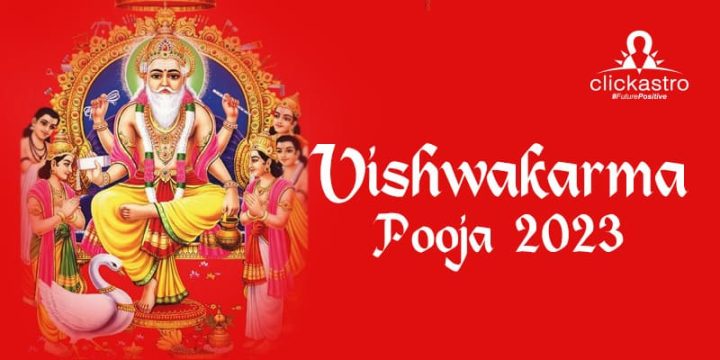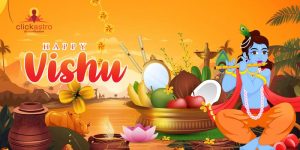Vishwakarma Puja, commonly referred to as Vishwakarma Jayanti is a prominent
Hindu festival characterized by fervor and deep-rooted devotion. This annual occasion is a heartfelt tribute to Lord Vishwakarma, revered as the divine architect and craftsman of the cosmos. Celebrated with unwavering enthusiasm, the festivities resonate not only in temples but also in the hearts of countless artisans, craftsmen, and factory workers throughout India. In the year 2023, this sacred observance graces the
calendar on September 17th.
The essence of Vishwakarma Puja lies in acknowledging the immense significance of craftsmanship and the role it plays in the fabric of society. It serves as a platform for devotees to seek the blessings of Lord Vishwakarma, a deity synonymous with success, prosperity, and safeguarding in the realm of creative and technical endeavors.
This article will delve into the rich heritage of Vishwakarma Puja, exploring the legends surrounding Lord Vishwakarma, the intricacies of its rituals, and its profound cultural relevance that transcends religious boundaries. As we journey through this, we’ll uncover the multifaceted layers that make Vishwakarma Puja a cherished and unifying celebration in the diverse list of Indian festivals.
The Legend of Lord Vishwakarma:
Lord Vishwakarma is described as the son of Lord Brahma, the creator of the universe. According to the ancient scriptures, Lord Vishwakarma is credited with constructing the celestial abodes of gods, including Indra’s Swarga (heaven), Lord Shiva’s abode in
Mount Kailash, and Lord Krishna’s city of Dwarka. His exceptional skills are showcased in various epics and legends, such as the creation of Lord Rama’s divine weapon, the celestial chariot for Arjuna in the Mahabharata, and the golden palace for Lord Vishnu.
Lord Vishwakarma is also associated with the construction of magnificent cities like Lanka, the kingdom of the demon king Ravana, and Hastinapur, the capital of the Kuru dynasty. His expertise in engineering and architecture is often depicted through his ability to create awe-inspiring structures and intricate designs.

In the chronicles of the Puranas, Lord Vishwakarma’s legacy extends further. His design and construction of Dwarka, the resplendent city that would serve as the capital of Lord Krishna’s kingdom, is a testament to his extraordinary craftsmanship, showcasing his ability to create not only divine realms but also earthly wonders.
The legend of Lord Vishwakarma continues to inspire and captivate, underscoring the profound significance of craftsmanship and artistry in Hindu culture. His enduring presence in the hearts of devotees reinforces the belief that creativity and skill are divine gifts, worthy of celebration and veneration during the auspicious occasion of Vishwakarma Puja.
Some of the creations attributed to Lord Vishwakarma are as follows:
Alakapuri:
The splendid city of Alakapuri was created by Vishwakarma on Mount Mandara upon request by Lord Kubera for a residence after becoming the god of wealth.
Pushpaka Vimana:
When Lord Kubera was facing a hard time, Lord Brahma felt sad for him. Intending to help Kubera, Lord Brahma asked Vishwakarma to build a flying chariot called the Pushpaka Vimana for Kubera. This chariot can obey any command such as right, left, forward, down, up, backward, etc.
Vajra:
Vishwakarma created the weapon Vajra out of the bone of sage Dadhichi for Lord Indra to kill Vritrasura.
Yamapuri:
Lord Vishwakarma also created Yamapuri for Yama Dev, his Yamadutas, and all his ministers and advisors.
ShraddhaVati:
Shraddhavati is the city of Varuna which was built by Lord Vishwakarma in the ocean.
Significance of Vishwakarma Puja:
The significance of Vishwakarma Puja is deeply intertwined with the pursuit of success, prosperity, and safety in the realm of craftsmanship and industrial endeavors. This revered festival serves as a poignant reminder of the vital role that Lord Vishwakarma plays in the lives of artisans, craftsmen, and industrial workers across India.
Devotees gather on this auspicious day to invoke the blessings of Lord Vishwakarma, seeking his divine guidance and protection in their creative and technical pursuits. It is a time when individuals pay homage to the celestial architect, recognizing his pivotal role in shaping the cosmos and the artistry inherent in the universe’s design.
Vishwakarma Puja transcends the boundaries of traditional craftsmanship and extends its embrace to the modern manufacturing sector, signifying the universal relevance of craftsmanship in contemporary society. It underscores the belief that every form of creative work, whether it involves intricate handiwork or cutting-edge technology, deserves acknowledgment and respect.
In essence, Vishwakarma Puja embodies the spirit of diligence, innovation, and reverence for skillful workmanship, making it a cherished occasion for all those who contribute to the vibrant culture of craftsmanship and industry. It is a day when aspirations for success and prosperity converge with gratitude for the divine blessings bestowed upon the artisans of the world.
The profound influence of Lord Vishwakarma on the realms of art, architecture, and craftsmanship reverberates through the corridors of history, transcending cultural boundaries. One can witness his celestial presence in the intricate carvings, lavish frescoes, and grand architectural wonders of ancient temples like Khajuraho, the Sun Temple of Konark, and the Meenakshi Temple. These creations reflect the divine fusion of craftsmanship, spirituality, and aesthetic beauty that continue to captivate and inspire generations.
This enduring reverence for Lord Vishwakarma underscores his timeless relevance, uniting both traditional and modern craftsmen under his benevolent guidance. His legacy continues to shape and elevate the pursuits of artisans and professionals across diverse fields, offering a bridge between ancient wisdom and contemporary aspirations.
Preparations and Rituals:
Cleaning and Decoration:
In the days leading up to the joyous celebration of Vishwakarma Puja, a palpable sense of anticipation fills workplaces, factories, and workshops across India. A significant part of the preparations involves meticulous cleaning, transforming these spaces into pristine sanctuaries of craftsmanship. Dust and clutter are banished, symbolizing the removal of obstacles and impurities, while the entire area is adorned with vibrant flowers. Furthermore, intricate rangoli patterns, featuring sacred symbols and motifs, grace the entrances. This practice not only beautifies the surroundings but also reflects the devotion and attention to detail that characterize the spirit of Vishwakarma Puja.
Idol Worship:
Central to the observance of Vishwakarma Puja is the ceremonial installation of an idol or image of Lord Vishwakarma within the workplace, factories, or workshops. This ritual signifies the divine presence of the celestial architect amidst the tools and creations of human craftsmanship. The installation of the idol is conducted with utmost reverence and devotion. Following this, a special puja, or worship, ensues. This act not only seeks the blessings of Lord Vishwakarma for success and prosperity but also serves as a poignant reminder of the sacredness inherent in all forms of craftsmanship and industry. It fosters a sense of unity among workers and artisans, affirming their dedication to their craft and the divine forces that inspire and guide their efforts.
Tools and Machinery:
On Vishwakarma Puja, it’s not just idols and images that receive devotion; the very instruments that enable craftsmanship and industry also take center stage. Tools, machines, and equipment used across various trades are meticulously cleansed and adorned. These tools and machinery are placed before the idol or image of Lord Vishwakarma. Incense is lighted, and prayers are recited, seeking the divine blessings of Lord Vishwakarma to ensure their flawless operation. This act of reverence underscores the belief that the smooth functioning of these tools is crucial for the success and prosperity of the artisans and industries they serve, making Vishwakarma Puja a holistic celebration of craftsmanship in all its facets.
Prayers and Aarti:
On the day of Vishwakarma Puja, devotees from various walks of life assemble in workplaces and factories to partake in prayers and aarti. This collective act of devotion is a momentous occasion where heartfelt supplications are offered to seek the divine architect’s guidance, protection, and blessings in their laborious endeavors. Devotees recite sacred prayers, invoking Lord Vishwakarma’s presence. During the aarti, the lamps are lit, incense is burned, and hymns are sung in unison, underscoring the deep-seated belief in the divine’s role as the ultimate source of inspiration and safeguarding in the realm of craftsmanship and industry.
The Cultural Impact:
Vishwakarma Puja extends its influence far beyond the confines of religious devotion, making a profound cultural impact that resonates with people of diverse backgrounds. This celebration serves as a unifying force, transcending religious boundaries and drawing together individuals from various walks of life.
The festival’s cultural significance lies in its ability to foster a deep sense of community and camaraderie among workers, artisans, and craftsmen. Regardless of their religious affiliations, people come together to honor the spirit of craftsmanship, acknowledging the role of skill, innovation, and hard work in shaping their lives and society as a whole.
Vishwakarma Puja reinforces the idea that the pursuit of excellence in one’s craft is a shared value, bridging gaps and promoting understanding among different cultural and religious groups. It exemplifies the inclusive and harmonious nature of India’s diverse cultural aspects, where devotion to craft unites people in a common celebration of creativity and diligence.
Regional Variations:
The celebration of Vishwakarma Puja across India exhibits fascinating regional variations, reflecting the rich cultural diversity within the country. These distinctions are a testament to the festival’s adaptability to local customs and traditions.
In some regions, particularly in states like West Bengal and Bihar, Vishwakarma Puja takes on a grand, public character. Streets come alive with vibrant processions featuring elaborately decorated idols of Lord Vishwakarma, accompanied by music and dance performances. These public festivities often include cultural programs and competitions, adding a dash of entertainment to the religious proceedings.
Conversely, in many other parts of India, the celebration is a more low-key and intimate affair, primarily observed within the confines of workplaces and factories. Here, the focus is on the rituals associated with the worship of tools, machinery, and Lord Vishwakarma, creating an atmosphere of sanctity within the workspace.
These regional variations in the observance of Vishwakarma Puja exemplify the festival’s adaptability, showcasing how it seamlessly blends with the diverse cultural landscapes of India while upholding its core values of craftsmanship, devotion, and community.
As Vishwakarma Puja 2023 dawns upon us, it beckons a moment of profound reflection and celebration. This auspicious occasion serves as a poignant reminder of the craftsmen and artisans who toil tirelessly to shape our world. It extols the virtues of creativity, innovation, and unwavering dedication, values that underpin every facet of our existence.
In the grand tapestry of our lives, Vishwakarma Puja threads the needle of spirituality and craftsmanship, weaving a beautiful narrative of devotion and hard work. It inspires us to recognize the divine in the details and to embrace the artistry that surrounds us, from the intricate handiwork of traditional artisans to the cutting-edge technology of modern industry.
As we gather to pay homage to Lord Vishwakarma and seek his blessings, let us also celebrate the spirit of unity and community that this festival fosters. May Vishwakarma Puja 2023 usher in a prosperous and harmonious future in all our endeavors, where the legacy of craftsmanship continues to shape the world. Happy Vishwakarma Puja to all!

 In the chronicles of the Puranas, Lord Vishwakarma’s legacy extends further. His design and construction of Dwarka, the resplendent city that would serve as the capital of Lord Krishna’s kingdom, is a testament to his extraordinary craftsmanship, showcasing his ability to create not only divine realms but also earthly wonders.
The legend of Lord Vishwakarma continues to inspire and captivate, underscoring the profound significance of craftsmanship and artistry in Hindu culture. His enduring presence in the hearts of devotees reinforces the belief that creativity and skill are divine gifts, worthy of celebration and veneration during the auspicious occasion of Vishwakarma Puja.
In the chronicles of the Puranas, Lord Vishwakarma’s legacy extends further. His design and construction of Dwarka, the resplendent city that would serve as the capital of Lord Krishna’s kingdom, is a testament to his extraordinary craftsmanship, showcasing his ability to create not only divine realms but also earthly wonders.
The legend of Lord Vishwakarma continues to inspire and captivate, underscoring the profound significance of craftsmanship and artistry in Hindu culture. His enduring presence in the hearts of devotees reinforces the belief that creativity and skill are divine gifts, worthy of celebration and veneration during the auspicious occasion of Vishwakarma Puja.







